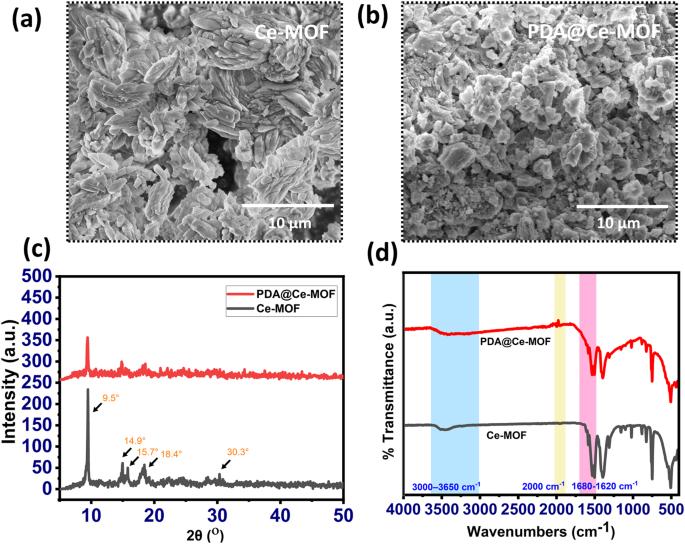Enhanced antifouling and separation capabilities of polydopamine@Ce-MOF functionalized PES ultrafiltration membrane
IF 10.4
1区 工程技术
Q1 ENGINEERING, CHEMICAL
引用次数: 0
Abstract
The need for antifouling membranes is substantial due to fouling’s negative impact on the effectiveness and durability of ultrafiltration membranes. In recent times, Metal-Organic Frameworks (MOFs) have emerged as effective additives for crafting ultrafiltration (UF) membranes. However, to harness their benefits and mitigate their drawbacks, a well-considered approach is imperative. In this work, polyethersulfone (PES) UF membranes were tailored with polydopamine (PDA)-modified cerium (Ce)-MOF (PDA@Ce-MOF) to achieve satisfactory antifouling properties and to remove biological macromolecules such as bovine serum albumin (BSA) and humic acid (HA) from wastewater. The non-solvent induced phase separation (NIPS) method was used to simultaneously fabricate the membrane and modify it with different PDA@Ce-MOF concentrations ranging from 0.05 to 0.50 wt.%. Results showed significant improvements on the membrane’s morphology, hydrophilicity, porosity and pore size at 0.10 wt.% loading of PDA@Ce-MOF. The synergistic effect of the PDA and Ce-MOF on the membrane improved the pure water flux (337 L m−2 h−1) and filtration performance in the filtration of Bovine serum albumin (BSA) and humic acid (HA) reporting 145 L m−2 h−1 and 98% rejection, and 164 L m−2 h−1 and 88% rejection; respectively. Further, water-attracting functional moieties of PDA@Ce-MOF hindered the deposition of BSA protein on the membrane surface, resulting in an excellent flux recovery ratio (FRR) of ~87%, alongside mitigated irreversible fouling.

增强聚多巴胺@Ce-MOF 功能化 PES 超滤膜的防污和分离能力
由于污垢会对超滤膜的有效性和耐用性产生负面影响,因此对防污膜的需求很大。近来,金属有机框架(MOFs)已成为制作超滤膜的有效添加剂。然而,要利用其优点并减轻其缺点,必须采用一种经过深思熟虑的方法。在这项研究中,聚醚砜(PES)超滤膜采用聚多巴胺(PDA)改性铈(Ce)-MOF(PDA@Ce-MOF)进行定制,以获得令人满意的防污性能,并去除废水中的生物大分子,如牛血清白蛋白(BSA)和腐殖酸(HA)。采用非溶剂诱导相分离(NIPS)方法同时制造膜,并用不同浓度(0.05 至 0.50 wt.%)的 PDA@Ce-MOF 对其进行改性。结果表明,在 PDA@Ce-MOF 含量为 0.10 wt.% 时,膜的形态、亲水性、孔隙率和孔径都有明显改善。PDA 和 Ce-MOF 对膜的协同作用提高了纯水通量(337 L m-2 h-1)和过滤性能,在过滤牛血清白蛋白(BSA)和腐植酸(HA)时,纯水通量分别为 145 L m-2 h-1 和 98%,腐植酸分别为 164 L m-2 h-1 和 88%。此外,PDA@Ce-MOF 的吸水官能团阻碍了 BSA 蛋白在膜表面的沉积,使通量回收率 (FRR) 达到约 87%,同时减轻了不可逆污垢。
本文章由计算机程序翻译,如有差异,请以英文原文为准。
求助全文
约1分钟内获得全文
求助全文
来源期刊

npj Clean Water
Environmental Science-Water Science and Technology
CiteScore
15.30
自引率
2.60%
发文量
61
审稿时长
5 weeks
期刊介绍:
npj Clean Water publishes high-quality papers that report cutting-edge science, technology, applications, policies, and societal issues contributing to a more sustainable supply of clean water. The journal's publications may also support and accelerate the achievement of Sustainable Development Goal 6, which focuses on clean water and sanitation.
 求助内容:
求助内容: 应助结果提醒方式:
应助结果提醒方式:


